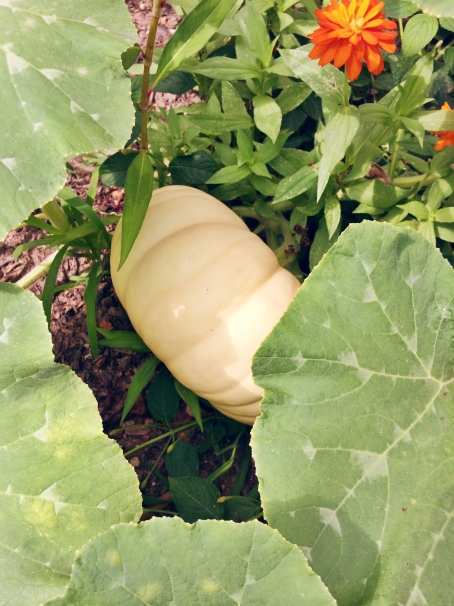The ‘Long Island Cheese’ Pumpkin
September 3, 2014 at 3:58 pm smithsoniangardens Leave a comment
This month we are collaborating with the National Museum of American History to present the second annual FOOD in the Garden evening series. Every Thursday in September we will explore one of four key maritime regions with connections to the War of 1812: the Long Island Sound, the Chesapeake Bay, the Great Lakes, and New Orleans. Join us tomorrow for a relaxed evening in the Victory Garden & enjoy fresh food and cocktails as we discuss the foodways and waterways of the Long Island Sound. Every week we’ll highlight a different plant from the Victory Garden with ties to the past and present agricultural heritage of the featured region.

‘Long Island Cheese’ heirloom pumpkin in the Victory Garden at the National Museum of American History.
The ‘Long Island Cheese’ pumpkin is a little-known heirloom with a mild, sweet flavor, making it a longstanding regional favorite for pies. This cream-colored pumpkin can be found peeking through its light-green leaves in our Victory Garden at the National Museum of American History. It was a popular variety in the Long Island Sound area in the 1800s, mentioned frequently in cookbooks and farmers’ almanacs, but is less common and harder to find in today’s modern markets. A member of the Cucurbita moschata species, this vine originated in Central or South America and made its way via trade and commerce to European and North American gardens as early as the 1500s. By the time of the Revolutionary War it was commonly found in gardens and markets up and down the Atlantic seaboard. In 1807, Bernard McMahon of Philadelphia introduced cheese pumpkin seeds to the commercial market. Cheese pumpkins made their way into seed catalogs and were popularly cultivated in the Long Island region.
The ‘Long Island Cheese’ pumpkin does not, in fact, taste like cheese at all—though we think it would make an excellent filling for ravioli. The flattened shape and the ribbed, light skin of the pumpkin resemble a wheel of cheese, a common sight in early American markets. Connecticut and the New England states were famous for their dairy production, exporting their delicious cheeses to other states and territories.
The medium-sized cheese pumpkins have deep orange, stringless flesh and a sweet taste, a perfect choice for pumpkin pie. According to one D.D. Tooker in an 1855 issue of the Michigan Farmer, cheese pumpkins were the pick of the pumpkins for any self-respecting pie baker:
The ‘Sweet pumpkin,’ alias ‘Cheese pumpkin’ or ‘pie squash,’—is the only true article, in my opinion, for making that most delicious of ‘yankee notions’—pumpkin pie—and I am not alone in my opinions, for I have yet to see the individual who would not agree with me in this matter . . . The shape and color of the fruit resembles that of a small sized dairy cheese, its flesh is very firm, fine grained and brittle, is of a rich orange color, and very sweet. They will keep all winter in a cool dry cellar if picked and stored before ‘Jack Frost’ touches them.
Seeds are still available from a variety of heirloom seed companies. Or be on the lookout for one in your local farmer’s market or pumpkin patch for the upcoming Thanksgiving baking season. As Tooker observed, this pumpkin stores very well in a cool, dry place.
Tomorrow evening, September 4th, FOOD in the Garden attendees will have the opportunity to sample spirits from Westford Hill Distillers, learn about the process of salt-making from Amagansett Sea Salt, and chat with the Smithsonian Gardens horticulturists who keep the Victory Garden growing. The evening’s panelists include Cindy Lobel, author of Urban Appetites: Food and Culture in Nineteenth-Century New York, Stephanie Villani, co-owner of Blue Moon Fish, and Diana Whitsit of Terry Farms.
More information about the program and how to purchase tickets for “Long Island Sound: Human Impact” can be found here.
Up next week: a pepper to spice up your seafood stew just in time for “Cultural Connections: The Chesapeake” on September 11th.
-Kate Fox, Smithsonian Gardens educator
Entry filed under: Garden History, Horticulture. Tags: food history, Food in the Garden, Heirloom plants, Long Island, National Museum of American History, pumpkin, Smithsonian, Victory Garden.

Trackback this post | Subscribe to the comments via RSS Feed